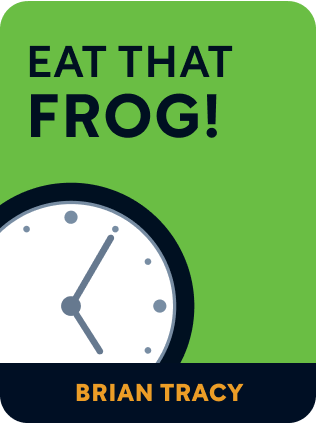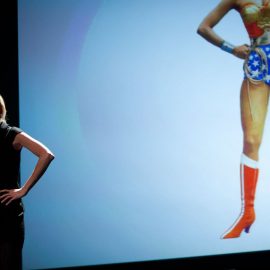

This article is an excerpt from the Shortform book guide to "Eat That Frog!" by Brian Tracy. Shortform has the world's best summaries and analyses of books you should be reading.
Like this article? Sign up for a free trial here .
What is the Eat the Frog technique from Brian Tracy’s Eat That Frog? How can learning this technique help you manage your time better?
Eat That Frog is based on Mark Twain’s metaphor for getting hard things done: if you have to eat a live frog, do it right away and everything after that will be easier by comparison. Brian Tracy used that metaphor to create the Eat the Frog technique in his time management book.
Keep reading to learn about the Eat the Frog technique.
Eat the Frog Technique
You’ll never get caught up or get ahead on everything you have to do, author Brian Tracy contends in Eat That Frog. There isn’t enough time in the day to meet all of the work and personal responsibilities you’re swamped with, let alone keep up with email, social media, projects, and all the books and articles you’ve been meaning to read. That’s why he developed the Eat the Frog technique.
Relying on productivity tools isn’t the answer because no matter how much time you save, there are more than enough incoming tasks to fill it. The only way to take charge of your time is to ignore most things—instead, focus on your most important task first and do it quickly and well.
If you’re able to get the most important things done consistently and efficiently, you can outperform the smartest person who fails to follow through. Mark Twain had a metaphor for getting hard things done: if you have to eat a live frog, do it right away and everything after that will be easier by comparison.
Your most important and consequential task—the one you’re most inclined to put off—is the frog.
Building on this insight, Tracy, a business consultant and trainer, offers practical tips gleaned from hundreds of books and articles for improving your productivity. Tracy tested the advice he read, and he compiled the most useful ideas. All are specific things you can do immediately to get results and be happier. Many of the ideas will also work in your personal life. The more quickly you apply these principles, the faster you’ll advance in your career.
Make It a Habit
The first part of the Eat the Frog technique is about forming habits. To succeed, you need to develop success habits. The key one is overcoming procrastination and tackling your most important task. With diligent practice, it eventually becomes automatic.
Making a habit of getting your most important things done has two payoffs: immediate satisfaction and long-term success.
Doing hard tasks successfully sets up a positive feedback loop. Completing a big job releases endorphins in your brain that make you feel good. A secret of success is that you can get addicted to these endorphin-induced feelings of self-confidence and capability. Subconsciously, you aim to complete more such tasks because you’re addicted to success. It’s one of the keys to long-term success and living a happy life. When you have a success habit, it becomes easier to do the important things than to dodge them.
How to Get Things Done
For this section of the Eat the Frog technique, here’s a list of Tracy’s favorite strategies for improving your productivity by focusing on the most important thing.
Prepare
1) Determine your goals: Determine what you want to accomplish, then write down your goals. There are seven steps for setting and achieving goals:
- Define your goal: Determine your goals in conjunction with your boss, so you’re clear about what you’re aiming for/what’s expected and in what order.
- Write it down: When you write down a goal, you make it real and concrete. A goal or objective that isn’t put into writing is short-lived.
- List the steps for achieving it: It’s easier to achieve your goal when it’s broken into individual tasks.
- Turn the list into a plan: Prioritize your tasks, and list things in the order they need to be done. With a written goal and a plan, you’ll be far more productive than if you had only a mental list.
- Set a deadline for achieving it: Set an overall deadline plus sub-deadlines for steps toward your goal. A goal needs definite deadlines with specific responsibilities to be completed—otherwise, you’ll procrastinate and get little done.
- Act on your plan: Just do something. Your plan may not be perfect, but it’s better to act on an average plan than to do nothing with a great plan.
- Do something every day to advance your goal: Put it on your schedule. For example, make a certain number of cold calls or exercise for 45 minutes. Don’t miss a day. Keep pressing forward.
2) Create work-life balance: Determine the three things you do at work that account for the majority of the value you contribute. Also, set personal or life goals in three areas: financial/career, relationship/family, and health/fitness. Focus each day on completing the most important things at work, so you have time to do what brings you happiness and satisfaction in your personal life. Your goal should be to do your best at work while not losing sight of the reasons you’re working: to have strong relationships and a satisfying life.
3) Know what’s expected of you: Identify the key areas of your job where you’re expected to deliver results, and make sure you focus on them. Your success and your company’s depend on your delivering these results. Grade yourself on each area on a scale of 1-10 to indicate your strengths and weaknesses. Instead of ignoring or rationalizing your weaknesses, focus on the expectations you need to meet and develop a plan for excelling in all areas. The better you get, the more motivated you’ll be to complete the important tasks.
4) Identify your biggest limitation: Identify the biggest thing that’s holding you, your project, or the company back and eliminate it. A constraint may be external to your company, internal, or even personal (everyone has personal limitations). Removing it will significantly speed up your progress toward your goal. Removing a limiting factor may be your most important task—or frog to eat—at the moment.
5) Build your skills: Continually upgrade your skills to increase your value and productivity and advance your career. Determine what you need to learn in order to do your job better. Identify your most important tasks and capabilities, then draw up a plan to continually upgrade your skills in these areas.
6) Plan each day: On a sheet of paper, list everything you have to do. A minute spent planning can save 10 in implementation. Whenever something comes up, add it to your list. When you work from a list, you can increase your productivity by 25%—two hours a day. Effective planning requires lists for different timeframes—daily, weekly, monthly—plus a master list and separate project lists. You move items between lists as you constantly prioritize.
Prioritize
7) Live by the 80/20 rule: 20% of your efforts will produce 80% of your results. Focus on doing the few things that make the most difference, or better yet, narrow it to one thing. If you have 10 things to do, doing the two most important ones will have a greater impact than doing the other eight combined. Each of the 10 tasks may take the same amount of time, but a certain one will generate more value—perhaps as much as 10 times more—than all the others. The most valuable task is the one you should complete first, or the frog you should eat first.
8) Weigh the consequences: The most important thing you can do is the one with the biggest consequences or greatest impact. Determine which thing that is by asking three productivity questions: “What are my most impactful activities,” “What can I alone do that will have a significant impact,” and “What’s the best use of my time at the moment?” Do the activity with the greatest impact first, especially if the consequences are positive. The greater the potential positive impact of a task, the more motivated you’ll be to stop procrastinating and get it done.
9) Be a creative procrastinator: Since you can’t do everything, you have to put off or eliminate something. Purposefully procrastinate on small things—for instance, answering non-urgent emails—so you can get the important things done.
10) Prioritize your to-do list: Prioritize your to-do list using the ABCDE labeling method to ensure you get the right things done. Label each task as follows:
- A—must do: These are tasks that are very important. They are tasks that you must do—not doing them will have serious negative consequences. For instance, an “A” task might be something your boss directed you to do,
- B—should do: These are tasks that you should do, such as returning a non-critical call or email. These tasks have much less dire consequences than “A” tasks—for instance, someone may be unhappy if you don’t do it.
- C—would be nice to do: These are tasks that would be nice to do, but it doesn’t matter whether you do them or not. Examples include having lunch with a coworker or phoning a friend. These tasks don’t affect your work.
- D—delegate: These are tasks you can delegate. You should delegate everything possible so you can create time to do your extremely consequential “A” tasks.
- E—eliminate: These are tasks you can eliminate. They include things that were important at one time but are no longer relevant, or unnecessary things that have become habits. Any time spent on one of these tasks is time diverted from an “A” task.
Take Action
11) Be fully prepared: Before you sit down and begin an important task, make sure you have everything you’ll need in front of you so you’re not distracted by looking for things later. Countless projects never get done, or are done haphazardly, because people fail to prepare for the job in advance. Once you have everything laid out like the ingredients for a recipe, start the task immediately.
12) Take it step by step: Make a big job doable by breaking into smaller steps and focusing on one step at a time. Imagine your large task is a salami that you’ve cut into thin slices, and you only need to eat one small slice at a time.
13) Motivate yourself: Coach yourself: use your inner voice to encourage and urge you to excel. Repeat to yourself, “I have what it takes” to build confidence and overcome doubt. Push yourself to complete your most important tasks by giving yourself deadlines and sub-deadlines. Approach your work with a sense of urgency, or a compulsion to get on with the job and get it done. When you know what you need to do, just do it.
14) Make technology work for you: Take control of your devices by using the available features to organize your work, remind you of what’s important, and keep unimportant things, such as social media and notifications, from wasting your time.
15) Stay focused: Focus on your most important task for two sustained 90-minute periods each morning. Use a planner to block out this time and stick to it. Eliminate interruptions and don’t multitask. Research indicates that the habit of responding to emails, texts, and calls results in a shorter attention span and a lack of focus, which make it impossible to complete the kind of tasks vital to your success.
Conclusion
The Eat the Frog technique concludes that developing the habit of doing your most important task, or eating your biggest frog, the first thing each workday primes you for success. Anyone can learn to do it. Following these rules can help you develop the habit and get on the road to success faster.

———End of Preview———
Like what you just read? Read the rest of the world's best book summary and analysis of Brian Tracy's "Eat That Frog!" at Shortform .
Here's what you'll find in our full Eat That Frog! summary :
- What it means to eat a frog
- How your daily distractions get in the way of doing important work first
- How to make a habit of doing the most important thing first, every day






